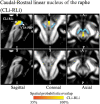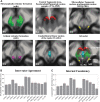Probabilistic Atlas of the Mesencephalic Reticular Formation, Isthmic Reticular Formation, Microcellular Tegmental Nucleus, Ventral Tegmental Area Nucleus Complex, and Caudal-Rostral Linear Raphe Nucleus Complex in Living Humans from 7 Tesla Magnetic Resonance Imaging
- PMID: 33926237
- PMCID: PMC8817713
- DOI: 10.1089/brain.2020.0975
Probabilistic Atlas of the Mesencephalic Reticular Formation, Isthmic Reticular Formation, Microcellular Tegmental Nucleus, Ventral Tegmental Area Nucleus Complex, and Caudal-Rostral Linear Raphe Nucleus Complex in Living Humans from 7 Tesla Magnetic Resonance Imaging
Abstract
Introduction: The mesencephalic reticular formation, isthmic reticular formation, microcellular tegmental nucleus, ventral tegmental area-parabrachial pigmented nucleus complex, and caudal-rostral linear nucleus of the raphe are small brainstem regions crucially involved in arousal, sleep, and reward. Yet, these nuclei are difficult to identify with magnetic resonance imaging (MRI) of living humans. In the current work, we developed a probabilistic atlas of these brainstem nuclei in living humans, using noninvasive ultra-high-field MRI. Methods: We acquired single-subject, multicontrast (diffusion and T2-weighted), 1.1-mm isotropic resolution, 7 Tesla MRI images of 12 healthy subjects. After preprocessing and alignment to the stereotactic space, these images were used to delineate (in each subject) the nuclei of interest based on the image contrast as well as on neighboring nuclei and landmarks. Nucleus labels were averaged across subjects to yield probabilistic labels. The latter were further validated by assessment of the label inter-rater agreement, internal consistency, and volume. Results: Labels were delineated for each nucleus with good overlap across subjects. The inter-rater agreement and internal consistency were below (p < 10-8) the linear spatial imaging resolution (1.1 mm), thus validating the generated probabilistic atlas labels. The volumes of our labels did not differ from literature volumes (p < 0.05), further validating our atlas. Discussion and Conclusion: The probabilistic atlas of these five mesopontine nuclei expands current in vivo brainstem nuclei atlases and can be used as a tool to identify the location of these areas in conventional (e.g., 3 Tesla) images. This might serve to unravel the brainstem structure-to-function link and thus improve clinical outcomes. Impact statement The mesencephalic reticular formation, isthmic reticular formation, microcellular tegmental nucleus, ventral tegmental area-parabrachial pigmented nucleus complex, and caudal-rostral linear nucleus of the raphe are small brainstem regions crucially involved in arousal, sleep, and reward. In the current work, we developed a probabilistic atlas of these brainstem nuclei in living humans, using noninvasive, ultra-high-field magnetic resonance imaging. The probabilistic atlas of these five mesopontine nuclei expands current in vivo brainstem nuclei atlases and can be used as a tool to identify the location of these areas in conventional (e.g., 3 Tesla) images. This might serve to unravel the brainstem structure-to-function link and thus improve clinical outcomes.
Keywords: brainstem nuclei atlas; caudal-rostral linear nucleus of the raphe; isthmic reticular formation; mesencephalic reticular formation; microcellular tegmental nucleus; ventral tegmental area-parabrachial pigmented nucleus complex.
Conflict of interest statement
Authors have no conflicts of interest to disclose.
Figures






Similar articles
-
Structural connectivity of autonomic, pain, limbic, and sensory brainstem nuclei in living humans based on 7 Tesla and 3 Tesla MRI.Hum Brain Mapp. 2022 Jul;43(10):3086-3112. doi: 10.1002/hbm.25836. Epub 2022 Mar 19. Hum Brain Mapp. 2022. PMID: 35305272 Free PMC article.
-
A probabilistic template of human mesopontine tegmental nuclei from in vivo 7T MRI.Neuroimage. 2018 Apr 15;170:222-230. doi: 10.1016/j.neuroimage.2017.04.070. Epub 2017 May 3. Neuroimage. 2018. PMID: 28476663 Free PMC article.
-
Functional connectome of brainstem nuclei involved in autonomic, limbic, pain and sensory processing in living humans from 7 Tesla resting state fMRI.Neuroimage. 2022 Apr 15;250:118925. doi: 10.1016/j.neuroimage.2022.118925. Epub 2022 Jan 21. Neuroimage. 2022. PMID: 35074504 Free PMC article.
-
Distribution of cholinergic, GABAergic and serotonergic neurons in the medial medullary reticular formation and their projections studied by cytotoxic lesions in the cat.Neuroscience. 1994 Oct;62(4):1155-78. doi: 10.1016/0306-4522(94)90351-4. Neuroscience. 1994. PMID: 7845592 Review.
-
The human raphe nuclei and the serotonergic system.J Chem Neuroanat. 2003 Dec;26(4):331-43. doi: 10.1016/j.jchemneu.2003.10.002. J Chem Neuroanat. 2003. PMID: 14729135 Review.
Cited by
-
In vivo structural connectome of arousal and motor brainstem nuclei by 7 Tesla and 3 Tesla MRI.Hum Brain Mapp. 2022 Oct 1;43(14):4397-4421. doi: 10.1002/hbm.25962. Epub 2022 May 28. Hum Brain Mapp. 2022. PMID: 35633277 Free PMC article.
-
Instructions and experiential learning have similar impacts on pain and pain-related brain responses but produce dissociations in value-based reversal learning.Elife. 2022 Nov 1;11:e73353. doi: 10.7554/eLife.73353. Elife. 2022. PMID: 36317867 Free PMC article.
-
Self-regulating arousal via pupil-based biofeedback.Nat Hum Behav. 2024 Jan;8(1):43-62. doi: 10.1038/s41562-023-01729-z. Epub 2023 Oct 30. Nat Hum Behav. 2024. PMID: 37904022 Free PMC article.
-
Sleep and Arousal Hubs and Ferromagnetic Ultrafine Particulate Matter and Nanoparticle Motion Under Electromagnetic Fields: Neurodegeneration, Sleep Disorders, Orexinergic Neurons, and Air Pollution in Young Urbanites.Toxics. 2025 Apr 8;13(4):284. doi: 10.3390/toxics13040284. Toxics. 2025. PMID: 40278600 Free PMC article.
-
Activity in the pontine reticular nuclei scales with handgrip force in humans.J Neurophysiol. 2024 May 1;131(5):807-814. doi: 10.1152/jn.00407.2023. Epub 2024 Mar 20. J Neurophysiol. 2024. PMID: 38505916 Free PMC article.
References
-
- Ayachit U. 2015. The Paraview Guide: A Parallel Visualization Application. NY, USA: Kitware, Inc.
-
- Barreiro-Iglesias A, Villar-Cerviño V, Anadón R, et al. . 2008. Development and organization of the descending serotonergic brainstem-spinal projections in the sea lamprey. J Chem Neuroanat 36:77–84. - PubMed
Publication types
MeSH terms
Grants and funding
LinkOut - more resources
Full Text Sources
Other Literature Sources

